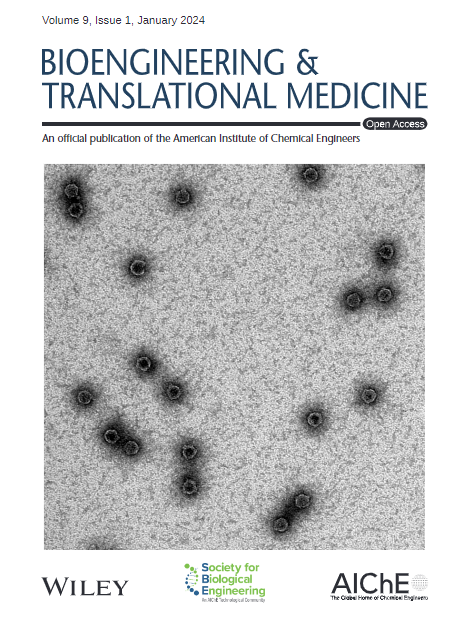纤维-电纺丝水凝胶治疗DNP:一种通过MMP9调节和钠通道抑制来减轻糖尿病神经性疼痛的协同电纺丝-水凝胶复合材料
IF 5.7
2区 医学
Q1 ENGINEERING, BIOMEDICAL
引用次数: 0
摘要
糖尿病神经性疼痛(DNP)仍然是糖尿病护理中的一个重大挑战,迫切需要有效的治疗策略。本研究介绍了一种新型的静电纺丝-水凝胶复合材料Fiber - SIN/Gel - LidC,用于青藤碱(SIN)和利多卡因(Lid)的控制和协同释放。生物信息学和网络药理学分析确定MMP9在DNP缓解中起关键作用。该复合材料由装载SIN的纤维和Lid微晶体组成,可确保药物持续释放超过7天,并表现出良好的生物相容性。糖尿病大鼠的体内实验显示,热痛阈和机械痛阈显著改善,坐骨神经兴奋性降低。此外,该复合物还能显著减轻神经炎症、神经元凋亡和形态学损伤。机制研究强调了纤维- SIN/凝胶- LidC的神经保护作用,特别是通过调节MMP9和抑制钠通道。这些研究结果表明,Fiber - SIN/Gel - LidC作为一种创新的基于生物材料的DNP治疗方法具有巨大的潜力,为糖尿病神经病变的治疗提供了广阔的前景。本文章由计算机程序翻译,如有差异,请以英文原文为准。
Fiber‐Electrospun Hydrogel Therapy for DNP: A synergistic electrospun‐hydrogel composite for alleviating diabetic neuropathic pain via MMP9 regulation and sodium channel inhibition
Diabetic neuropathic pain (DNP) remains a significant challenge in diabetes care, and effective therapeutic strategies are urgently needed. This study introduces an innovative electrospinning‐hydrogel composite, Fiber‐SIN/Gel‐LidC, designed for the controlled and synergistic release of Sinomenine (SIN) and Lidocaine (Lid). Bioinformatics and network pharmacology analyses identified MMP9 as a key player in DNP alleviation. The composite, composed of SIN‐loaded fibers and Lid microcrystals, ensures sustained drug release over 7 days, demonstrating excellent biocompatibility. In vivo experiments on diabetic rats revealed significant improvements in thermal and mechanical pain thresholds, along with a reduction in sciatic nerve excitability. Additionally, the composite significantly attenuated neuroinflammation, neuronal apoptosis, and morphological damage. Mechanistic studies highlighted the neuroprotective effects of Fiber‐SIN/Gel‐LidC, particularly through the regulation of MMP9 and inhibition of sodium channels. These findings suggest that Fiber‐SIN/Gel‐LidC holds great potential as an innovative biomaterial‐based approach for managing DNP, offering promising therapeutic prospects for diabetic neuropathy.
求助全文
通过发布文献求助,成功后即可免费获取论文全文。
去求助
来源期刊

Bioengineering & Translational Medicine
Pharmacology, Toxicology and Pharmaceutics-Pharmaceutical Science
CiteScore
8.40
自引率
4.10%
发文量
150
审稿时长
12 weeks
期刊介绍:
Bioengineering & Translational Medicine, an official, peer-reviewed online open-access journal of the American Institute of Chemical Engineers (AIChE) and the Society for Biological Engineering (SBE), focuses on how chemical and biological engineering approaches drive innovative technologies and solutions that impact clinical practice and commercial healthcare products.
 求助内容:
求助内容: 应助结果提醒方式:
应助结果提醒方式:


